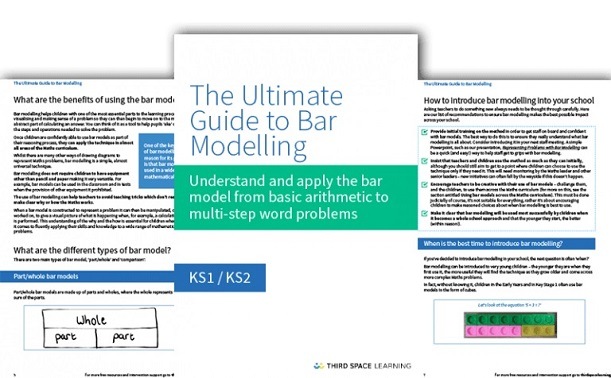Free Bar Modelling PowerPoint And Other Ways To Showcase The Use Of The Bar Model
Now that bar modelling is a staple of classrooms across the UK, we thought it was time to show you how we here at Third Space Learning use this pictorial representation within our 1-to-1 intervention lessons. The aim is to give you a few ideas of how you can use it too no matter what primary school year you teach maths to. Bar models for all we say!
While maths used to be taught by working out page after page of calculations until the theory behind what you were doing got hammered into your brain through constant repetition.
The idea of using pictures as part of teaching maths was a rarity, but one idea that was introduced in the 1960s by Jerome Bruner – is now at the forefront of maths teaching – the concrete pictorial abstract approach (CPA), most frequently seen in our increasing use of the bar model!
Bar Modelling Powerpoint And Other Resources
If you think you need a quick revision on the bar model before you start, we have lots of resources to help you out.
Start here: What is a bar model and then have a look at our bar modelling ppt: The Ultimate Guide To Bar Modelling which covers:
- What bar models are
- The benefits of using them
- How to introduce them into your school
- Which types of maths problems they can help you to solve
- Much, much more!
What Is Bar Modelling?
The bar model method (sometimes known as the Singapore bar method) is a way of representing maths problems pictorially. Its use was popularised through the Singapore maths method, a maths mastery-focused teaching strategy from (unsurprisingly) Singapore that has been increasingly used in the UK.
A bar model is, put simply, a diagram designed to aid with maths problem solving. Learners draw bars that are used to represent the known and unknown quantities in a problem, helping them visualise and contextualise all the relevant information in a question. This is especially important for complex word problems, where pupils might get confused by the ‘surface’ information.
Bar modelling is one way of supporting children through the pictorial stage of the CPA approach to learning; bar models aren’t calculations themselves; they act as a visual comparison model that helps learners decide which operation to use to solve the problem.
Bar models are often introduced with addition and subtraction problems, as these can be easily represented using bars of differing lengths. They can also be used with more complex topics however, such as statistics and data handling, percentages and so on.
While bar modelling is mainly used with Key Stage 2 pupils, it can be introduced in Key Stage 1 to great effect. It is usually too advanced for use with early years, however.
How We Use Bar Modelling
What I want to do in this post is outline how we use bar models here at Third Space Learning and how alongside our maths intervention the resources we have created could be effectively used to improve your teaching.
The core of the Third Space Learning offer is of course the pedagogy behind our online maths tuition, because we are able to gauge immediately after every lesson, how successful it was and what we could do to improve it. In any week up to 6,000 pupils will be receiving one of our 270 lessons, and we record every lesson a child receives from their tutor so we can look back and review where and how progress was made or additional scaffolding was required.
Since we started teaching 1-to-1 online in 2014 we’ve vastly increased the pictorial representations we use. Like many schools following a mastery approach to maths, we find that they just help children to develop deeper conceptual understanding. And far and away, the bar model is the best of the tools we use!
The Ultimate Guide to Bar Modelling
Get to grips with using the bar model method - from basic arithmetic to multi-step problems - ready to help your pupils use it in their lessons!
Download Free Now!Which topics are suitable for bar modelling?
Bar modelling is a mastery maths method that can be used to help teach many topics in maths, from place value and the four operations through to fractions to ratios. Their versatility is one of their strongest points in your classroom, and our online one too!
Find out more about teaching for mastery with our maths mastery toolkit.
Bar models are particularly useful if lessons where greater explanation is needed. Here are the bar model methods we use across the maths curriculum to teach key topics.
Using bar modelling to teach fractions
From lessons on Simple equivalent fractions to Adding and Subtracting all kinds of fractions to Fraction problems, this topic is made more visual and easier to understand by simply inserting bar models into the lessons.
The nature of fractions makes the bar model the perfect way to teach them, and pupils often dividing a bar into the appropriate fraction very simple.
Our interactive learning platform means that no matter what question comes up, or what the conversation is that follows on from a question, both tutor and pupil are free to create their own bar model to help cement the point at hand.
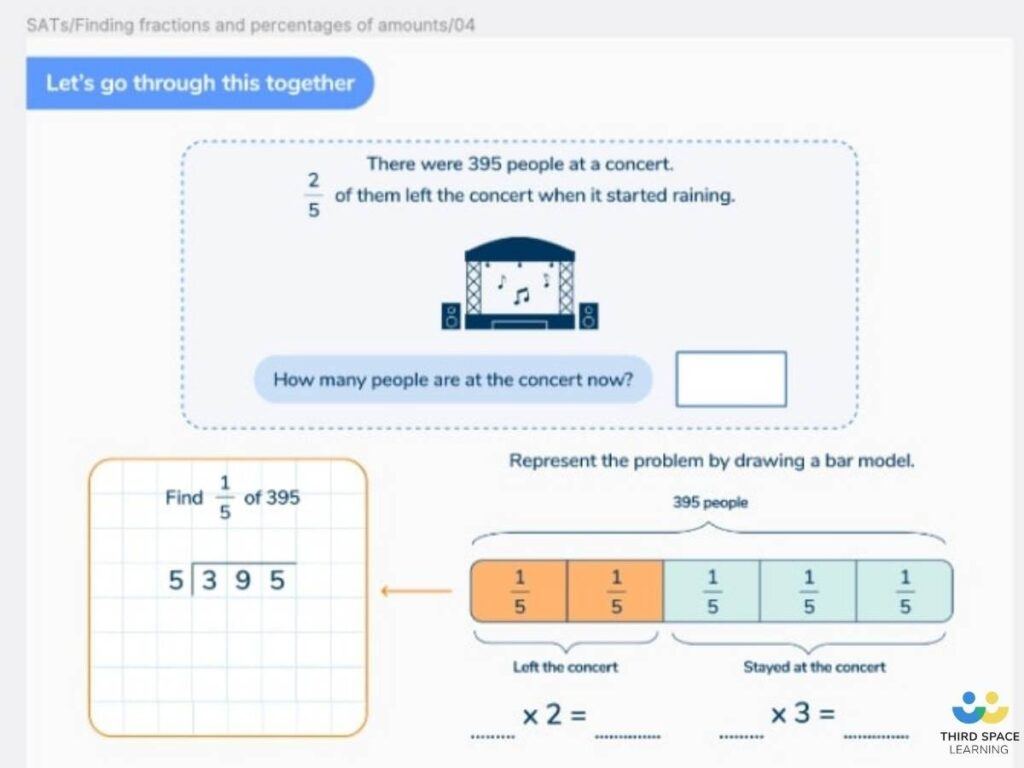
You may not have even known you were using a fraction bar model when teaching fractions.
Hands up all those teachers who’ve used a fraction wall?
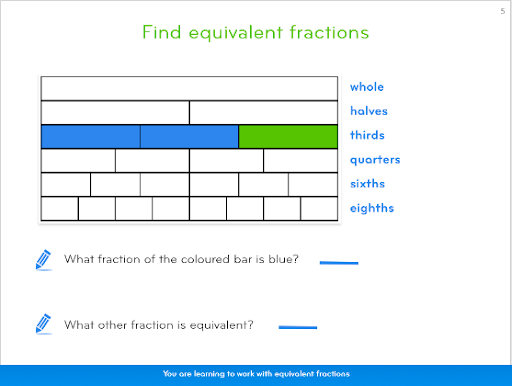
There you go, you’ve used a bar model!
To learn more about how the platform works, including about how we use the bar model, get in touch with the team today.
Using bar modelling to teach ratio and rates
Another pair of topics that lend themselves to the bar model well, ratio and rate based questions can be presented easily in a visual manner as a way to help pupils solve problems. As shown in the example below, by breaking the problem down in such a way, our tutors can explain the problem step-by-step to help ensure that the point has come across.
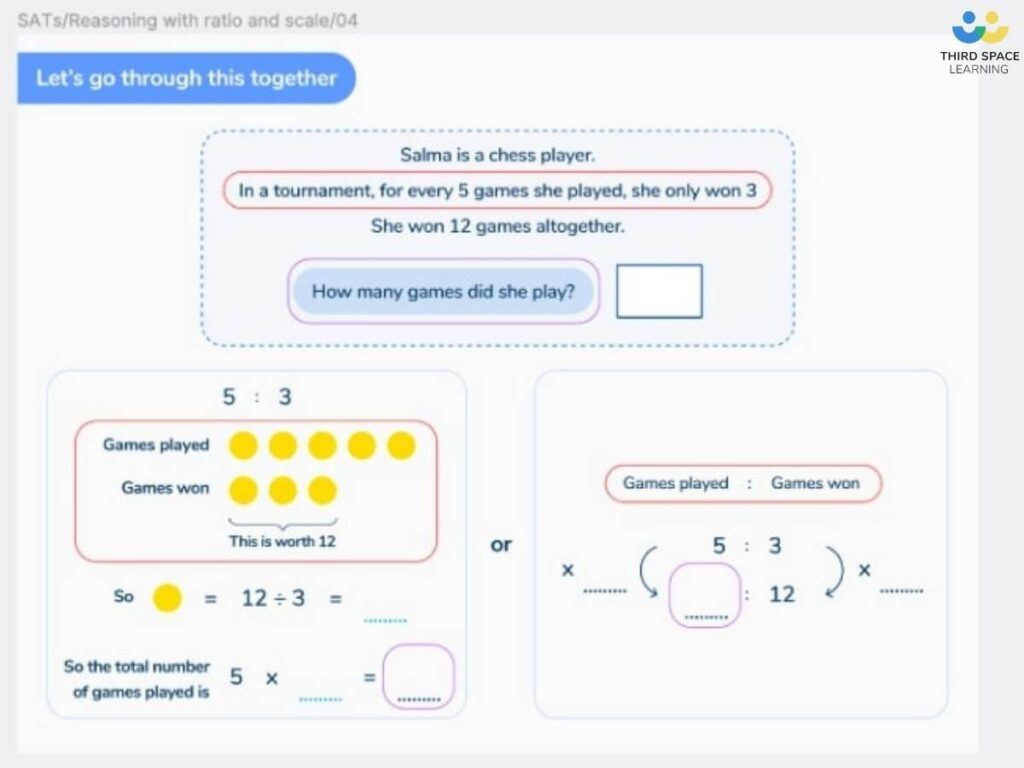
Using bar modelling with word and number problems, estimating and decimals
Bar models are incredibly useful when working out KS2 SATs style Year 6 word problems or calculations involving number problems, estimation or decimals.
A bar model allows you to ‘unpack’ the question and set it out visually so that the child can see the difference in size of the bar models, depending on the size of the number, which can then help them to work out what the question is asking them to do.
In the example below, a tutor might first help a pupil use the bar model to estimate the value of the blue bar using the orange and purple bars, then help them attempt the inverse – using the estimated value of the blue bar to check that a subtraction yields a similar result.
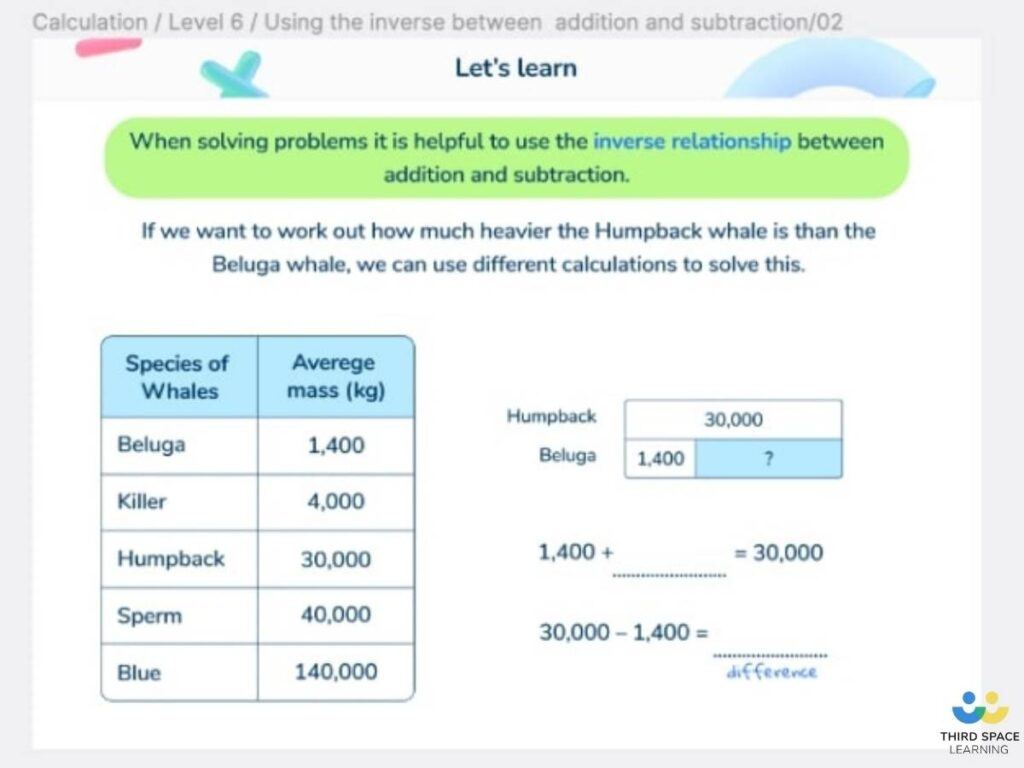
Why We Use The Bar Model In Our Lessons
At Third Space Learning, we support the focus on helping children master the topics they are taught in maths, and our adoption of bar models across our various resources and one to one maths lessons demonstrates our desire to give children every tool they need to tackle the maths problems they face.
For most topics in maths there are several ways to teach it. We just find that the bar model is an effective and efficient way to really embed conceptual understanding and understand how to get to the answer.
Our goal at Third Space Learning is to not only provide world class 1-to-1 tuition via our interventions, but to make pupils confident and well-rounded learners, utilising as many methods and ideas as possible to solve any problem they are given.
Bar models allow pupils to become more involved in their learning and as Benjamin Franklin said:
“Tell me and I forget. Teach me and I remember. Involve me and I learn.”
Why We Don’t Use Bar Modelling For Every Topic
Crucially, we have only used bar models in a selection of lessons, as using them in every lesson would not only devalue their importance, but make pupils think that they are the only way to work out every problem.
While bar models can be used for most topics in maths, including multi-step word problems, they are only one of many tools that a pupil should be taught.
More Bar Modelling CPD: Bar Model Videos
If you explore the Third Space Learning Maths Hub, you will find that one of the topics is entitled Bar Models. Click on this and you will find over 30 videos on how to use bar models to teach a variety of subjects, from solving percentage problems to complex KS2 bar model multiplication problems, as well as videos explaining the basics of bar models and how to introduce them into Year 6.

These videos are quick, usually being a few minutes long which means that they are great for teachers and children alike.
How you can use these bar modelling videos
As a teacher, you can use these videos whilst planning your lessons, to give you ideas about how to teach the topic or as a new way to approach the subject.
They can be used within lessons as starters, reminders or as part of a flipped learning platform, with pupils watching them at home, ready to use these skills to solve problems in class.
As mentioned, the collection of 34 videos we have on the Maths Hub on bar modelling covers a wide range of topics, and some of the subjects you will find covered include:
- Bar Modelling: An Introduction
- Bar Modelling: The Basics Explained
- How To Use Bar Models To Help Solve A Multi Step Worded Fraction Problem
- How To Use Bar Modelling For A Subtraction Problem
- How To Get Pupils Solving Equations Using Bar Models
- How To Solve A Complex Addition And Subtraction Word Problem Using Bar Modelling
- How To Introduce Bar Modelling In Year 6
- How To Use Bar Models To Solve A Simple Multiplication Problem
- How To Use The Bar Model To Solve Multiplicative “Times Bigger” Problems
- How To Use Bar Models To Solve Complex Problems Additive And Multiplicative Relationships
- How To Use Bar Models To Solve A Simple Subtraction Problem
- An Introduction To Bar Models For Comparison Problems
- How To Use Bar Models To Help Solve A Multi Step Worded Multiplication Problem
- How To Use Bar Models To Solve A Simple Fraction Problem
- How To Use The Bar Model To Solve Percentage Problems
Final thoughts
In summary:
- Bar models are an excellent way of visually portraying a problem, making it easier for pupils to understand what they are being asked to do.
- Bar models should be used as one example of methods to solve problems, and are especially useful for certain topics, such as fractions, ratios or missing number problems.
- Bar models can be used with children of any age group or ability, on a variety of mediums, from videos to whiteboards to multi-link cubes.
- Bar models are especially useful when teaching pupils with learning difficulties or special needs, who might respond better to visual prompts.
- Bar models form an important part of our 1-to-1 lessons as they give us a great chance to help pupils solve their problems in a visual manner. This can be replicated easily in the classroom too.
Read more
DO YOU HAVE STUDENTS WHO NEED MORE SUPPORT IN MATHS?
Every week Third Space Learning’s specialist online maths tutors support thousands of students across hundreds of schools with weekly online 1 to 1 maths lessons designed to plug gaps and boost progress.
Since 2013 these personalised one to one lessons have helped over 150,000 primary and secondary students become more confident, able mathematicians.
Learn how the programmes are aligned to maths mastery teaching or request a personalised quote for your school to speak to us about your school’s needs and how we can help.

